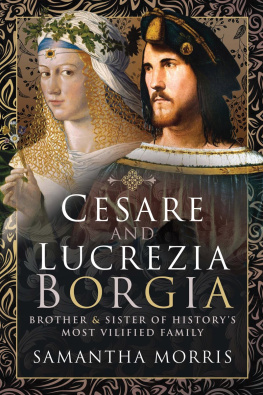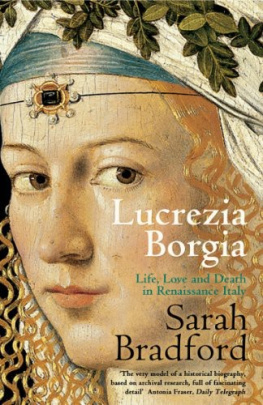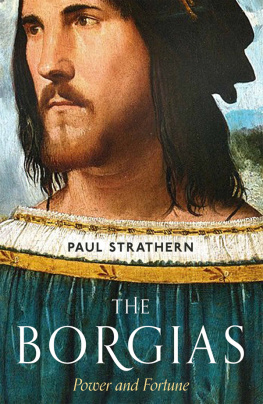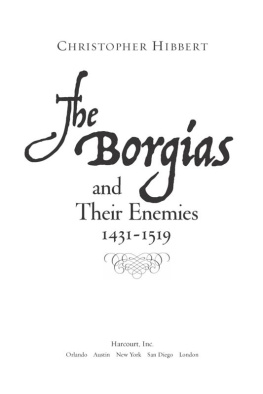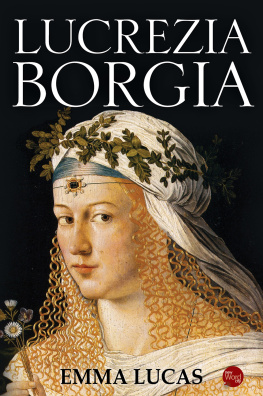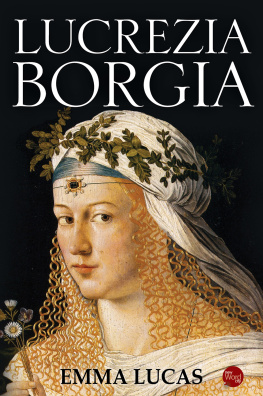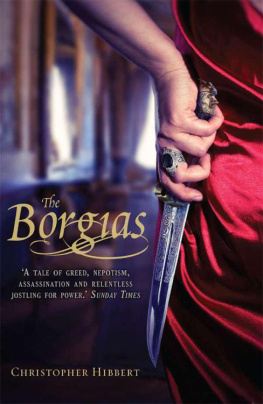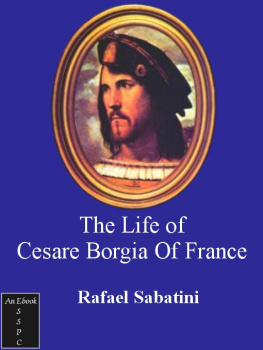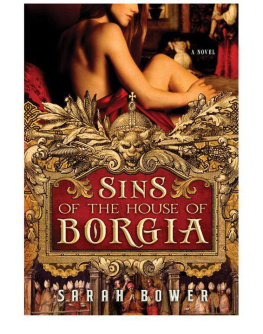Pagebreaks of the print version

Cesare and Lucrezia Borgia
To my Grandad, John Morris.
For your support, and for telling me how proud you were.
Wherever you are, I hope you have a copy of this book.
Rest in Peace.
Cesare and Lucrezia Borgia
Brother and Sister of Historys Most Vilified Family
Samantha Morris
First published in Great Britain in 2020 by
Pen & Sword History An imprint of
Pen & Sword Books Ltd
Yorkshire Philadelphia
Copyright Samantha Morris 2020
ISBN 978 1 52672 440 3
eISBN 978 1 52672 441 0
Mobi ISBN 978 1 52672 442 7
The right of Samantha Morris to be identified as Author of this work has been asserted by her in accordance with the Copyright, Designs and Patents Act 1988.
A CIP catalogue record for this book is available from the British Library.
All rights reserved. No part of this book may be reproduced or transmitted in any form or by any means, electronic or mechanical including photocopying, recording or by any information storage and retrieval system, without permission from the Publisher in writing.
Padstow, Cornwall.
Pen & Sword Books Limited incorporates the imprints of Atlas, Archaeology, Aviation, Discovery, Family History, Fiction, History, Maritime, Military, Military Classics, Politics, Select, Transport, True Crime, Air World, Frontline Publishing, Leo Cooper, Remember When, Seaforth Publishing, The Praetorian Press, Wharncliffe Local History, Wharncliffe Transport, Wharncliffe True Crime and White Owl.
For a complete list of Pen & Sword titles please contact
PEN & SWORD BOOKS LIMITED
47 Church Street, Barnsley, South Yorkshire, S70 2AS, England
E-mail:
Website: www.pen-and-sword.co.uk
Or
PEN AND SWORD BOOKS
1950 Lawrence Rd, Havertown, PA 19083, USA
E-mail:
Website: www.penandswordbooks.com
Acknowledgments
T he writing of this book has taken years and has truly taken me on an incredible journey. However none of this could not have been possible without the help of some wonderful individuals, to who I owe a great deal of thanks.
First of all I would like to say thank you to the incredibly helpful staff at the Vatican Archives who helped me locate various documents and books. Whilst I did not have the opportunity to visit the archives in person, the staff pointed me in the direction of various sources both held in their online archives and elsewhere in the public domain.
A special thank you goes to my partner, Matt, for his love and again his patience whilst I have worked on this gargantuan project. He has been with me every step of the way and listened to me babble on about the Borgia family from dawn till dusk and visiting places associated with the Borgia without even a grumble. In fact, he has grown to love the family almost as much as I do!
The support of my family has been invaluable during my writing. My mum and dad have been so supportive in my endeavours, from the moment I first said I wanted to write a history book. I would also like to extend a heartfelt thank you to my grandad, John Morris, to whom this book is dedicated. The day before he passed we had a long conversation about my writing work and he told me how he had copies of my previous work and that he was looking forward to reading this one when it came out. This book is for you, Grandad, and I hope wherever you are that you enjoy reading it.
I would also like to extend a very special thank you to Pen and Sword publishing for taking a chance with this book and for their support and guidance through this whole process.
And finally, thank you to everyone who has supported me on this endeavour. There are far too many of you to name, but thank you for reading my work and encouraging me to continue on this incredible journey.
Samantha Morris
Southampton, 2019
Introduction
J ust beyond the Raphael Rooms in the Vatican Museums are the Borgia apartments today these rooms house a modern art exhibition looked down upon by the murals of Pinturrichio and the faces of the Borgia family. The rooms are often not as busy as the rest of the museums as they are off the beaten track, only really available for visitors if you go searching for them once youve fought your way through the crowded Sistine chapel. Guided tours, however, will often take their groups through the rooms and talk about what they, and most people who know of the Borgia family, believe to be the truth. In much the same way as the Beefeaters at the Tower of London tell the story that Anne Boleyn was brought in through Traitors Gate (she wasnt), the Tour Guides tell their groups that the Borgia family committed myriad crimes including the one of incest. Murder, poison and corruption also feature highly in their tales of the family and two names often come up Cesare and Lucrezia Borgia. Their faces gaze down upon the tourists from the beautiful murals within the Room of the Saints, part of a number of rooms that made up Alexander VIs secret apartments within the Apostolic Palace, and one can only imagine how these two individuals would feel if they knew the rumours started by their enemies were still spoken about in our modern times as if they were fact, rather than what they were; vicious gossip and hearsay.
The stories that are told not only by the tour guides of the Vatican but also by modern day media must have come from somewhere. Indeed, the family was surrounded by enemies who disliked the sheer power held by a family of Spaniards. Italy at the time was rife with xenophobia as well as jealousy if another family could not get what they wanted out of the Borgia family, then they would quickly turn on them, dripping poisonous rumours into the ears of everyone who would listen. During the time of the Borgias, Italy as a country did not exist but rather was made up of a conglomeration of separate states that were ruled by their own princes, some of whom gave their allegiance to the Pope whilst others ruled only for themselves. These rulers were often incredibly powerful families for instance the Sforza family ruled Milan and the Medici ruled Florence until they were deposed by Florentine signoria and the monk Savonarola. Other states were under the dominion of other European powers Mantua, ruled by the Gonzaga, was a fiefdom of the Holy Roman Empire whilst other areas such as Ferrara were allies of France and Naples to Spain. Italy as a unified nation state did not come into being until 1861 and in June 1946, Italy abolished its monarchy altogether after a referendum was held.
One can only imagine the conversations that were whispered throughout the courts of Europe throughout the Borgia Papacy, poison dripped into the ears of anyone who wanted to believe that the most powerful family in the Catholic world were caught up in all sorts of scandal. Rumours abounded of incest and sexual intrigue, of fratricide and poisoning. And at the centre of these rumours, along with the Pope, two names were a constant. Cesare and Lucrezia Borgia, brother and sister, were said to be lovers. Lucrezia was said to poison her enemies whilst Cesares name was whispered in fear.
Even after his death in 1507, Cesare Borgias name was synonymous with evil. His sister, despite becoming more and more pious as the years went on, was still accused of sexual intrigue. These ideas about the most famous siblings in Renaissance history have stuck and have come down to us today. But the question is, why have they remained in the public imagination? Where did the hatred come from? Where did the rumours of incest stem from?

